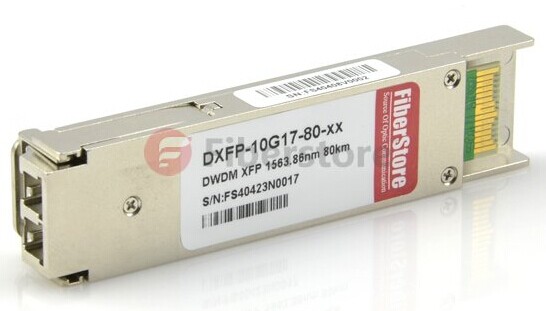On January 16th, 2003, the 10 Gigabit Small Form-factor Pluggable (XFP) Module Group, a module multi-source agreement (MSA) association, announced that the XFP specification is available for final public review. Since then, MSA form factors for 10 Gbit/s optical transceivers have evolved along two separate paths that are now converging on XFP as a universal long-term solution. XFP transceiver is an ultra-small, hot-pluggable, 10 Gbit/s optical transceiver designed to help drive cost and power consumption out of 10 Gbit/s optical networking applications, and enables rapid advances in port density after the previous X2 and XPAK transceiver as well.

Types of XFP Transceiver
XFP are available with a variety of transmitter and receiver types, allowing users to select the appropriate transceiver for each link to provide the required optical reach over the available optical fiber type (e.g. multi-mode fiber or single-mode fiber). XFP transceiver modules are commonly available in several different categories:
SR - 850 nm, for a maximum of 300 m
LR - 1310 nm, for distances up to 10 km
ER - 1550 nm, for distances up to 40 km
ZR - 1550 nm, for distances up to 80 km
The XFP packaging is smaller than the XENPAK form-factor which is published earlier.
SR - 850 nm, for a maximum of 300 m
LR - 1310 nm, for distances up to 10 km
ER - 1550 nm, for distances up to 40 km
ZR - 1550 nm, for distances up to 80 km
The XFP packaging is smaller than the XENPAK form-factor which is published earlier.
Advantages of XFP Transceiver
XFP transceiver modules have many outstanding advantages as follows:
• Hot pluggability
• Available for various transmission distance ranging from 300 m to 80 km
• Operate over a single wavelength or use dense wavelength-division multiplexing techniques
• Compliance with XFP Multi-Source Agreement (MSA)
• Digital diagnostic monitoring
• Use LC fiber connector type to achieve high density
• A 1310nm directly modulated laser with PIN for 10 km
• A 1550nm cooled EML with PIN for 40 or 80 km
Besides, XFP transceiver costs approximately 30% to 40% less than earlier MSA form factors, and is far more compact, giving two to three times the density. As it is multiprotocol and hot-pluggable, it's not surprising that the industries are lining up behind it. Its versatility, low cost, and small footprint are making XFP transceiver the choice for an ever-growing set of 10 Gbit/s communications applications.
• Hot pluggability
• Available for various transmission distance ranging from 300 m to 80 km
• Operate over a single wavelength or use dense wavelength-division multiplexing techniques
• Compliance with XFP Multi-Source Agreement (MSA)
• Digital diagnostic monitoring
• Use LC fiber connector type to achieve high density
• A 1310nm directly modulated laser with PIN for 10 km
• A 1550nm cooled EML with PIN for 40 or 80 km
Besides, XFP transceiver costs approximately 30% to 40% less than earlier MSA form factors, and is far more compact, giving two to three times the density. As it is multiprotocol and hot-pluggable, it's not surprising that the industries are lining up behind it. Its versatility, low cost, and small footprint are making XFP transceiver the choice for an ever-growing set of 10 Gbit/s communications applications.
Applications of XFP Transceiver
XFP transceiver supports 10 Gigabit Ethernet, 10 Gbit/s Fibre Channel, synchronous optical networking (SONET) at OC-192 rates, synchronous optical networking STM-64, 10 Gbit/s Optical Transport Network(OTN) OTU-2, and parallel optics links. The XFP transceiver can be applied in longer reach applications for the metro-WDM market, which requires a cost-optimized, managed platform supporting different services and suitable for applications in diversified network topologies. And the CWDM/DWDM XFP transceivers are designed to be compatible with existing technologies already deployed in the field, interworking with SDH/SONET. With DWDM XFP transceivers, the system can support both C-band and L-band applications.
Fiberstore manufactures and supplies a complete range of XFP transceiver modules which can be customized. In addition, Fiberstore also provides compatible XFP transceivers as alternatives to those branded by Cisco, HP, Juniper Networks. The aim is to offer customers high-performance and cost-effective products to fulfill their requirements, contributing this way to the customer's success and satisfaction.
Originally published at http://www.sfp-transceiver-modules.com/wiki_list
No comments:
Post a Comment